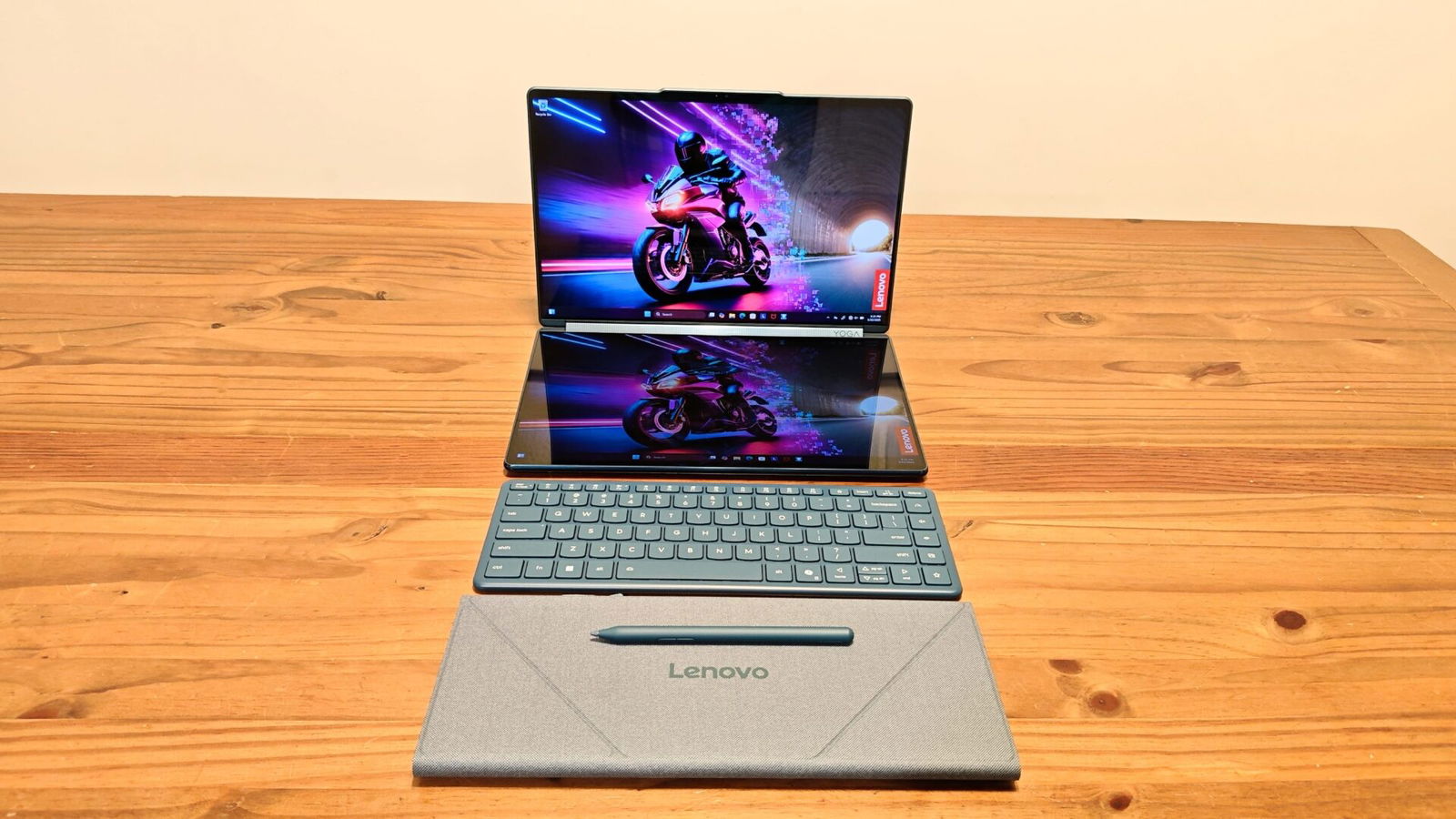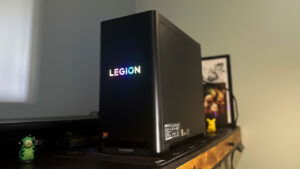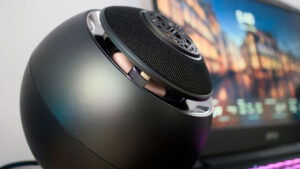The Lenovo Yoga Book 9i is a uniquely designed dual-screen laptop built as the ultimate multitasking system. Designed with two 14” displays, Intel’s Core Ultra 7 255H processor, and the most adaptable configuration selection I’ve seen in a laptop. Comprised of an all-aluminum chassis and POLED screens, the Yoga Book 9i is built to handle the robust circumstances in which this adaptable laptop might find itself. While there is plenty to be impressed with in the Yoga Book 9i’s overall design, there are a few areas where Lenovo’s latest innovation could still use some refinement.
The Yoga Book 9i’s design is by far one of the best implementations of the dual-screen design I’ve seen to date. It offers two beautiful POLED (plastic OLED) displays that are perfect for its transforming design. On the note of transforming, perhaps the most impressive element of the Yoga Book 9i is found in its adaptable nature. Able to swap between different ‘setups’, the 9i is the most customizable working laptop on the market.
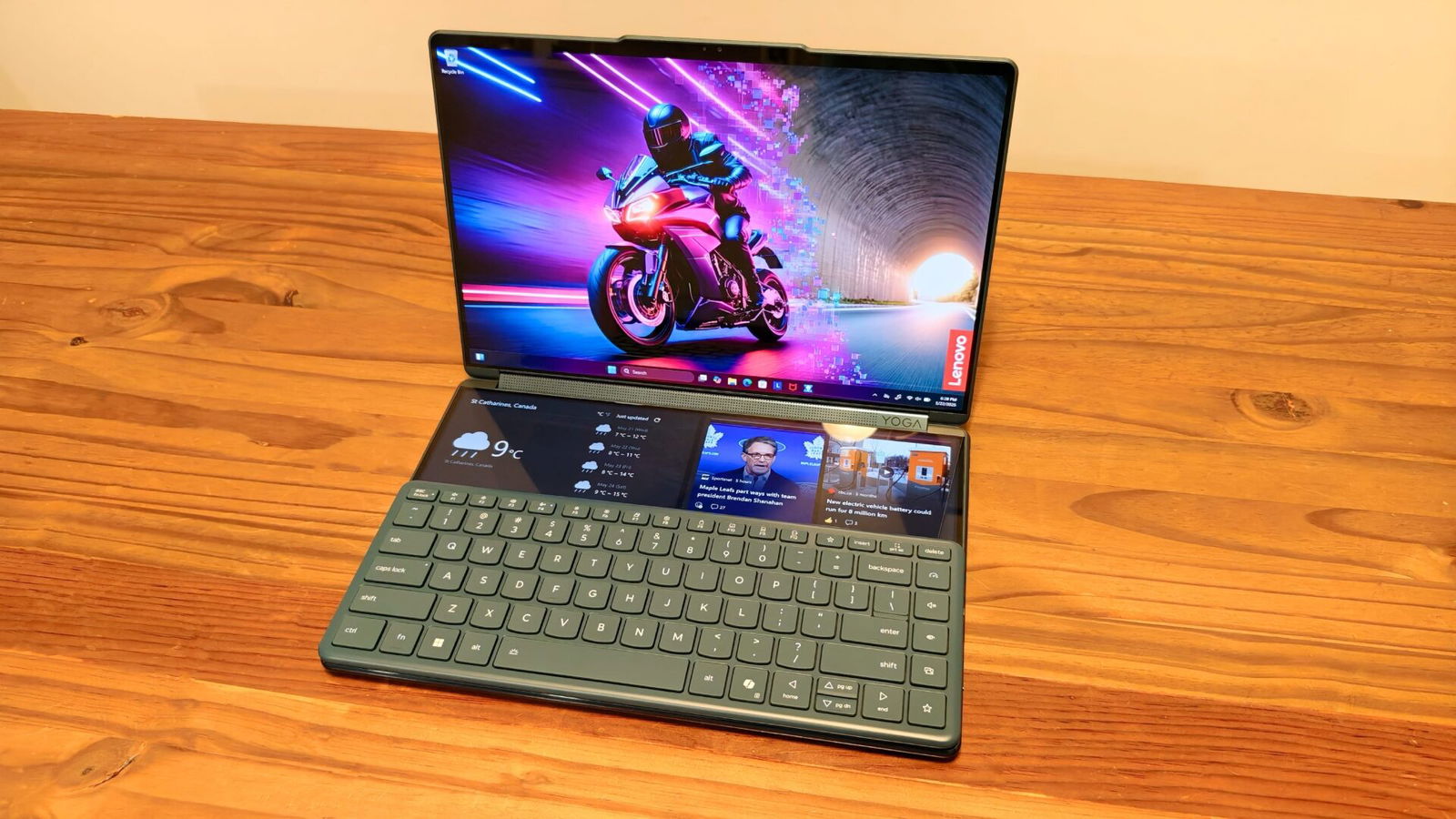
Constructed of the aforementioned aluminum chassis, the Yoga Book 9i feels durable when carried around your laptop bag or in your hand. This durable design is further reinforced by the POLED touch screens, which can take much more abuse than traditional glass. For those concerned with the visual performance of a plastic OLED display, rest assured, these displays gorgeous to behold and use.
Speaking of the POLED displays, the Yoga Book 9i features two 16:10 PureSight POLED displays. Both touchscreen-enabled, these displays provide an incredibly vibrant visual experience. Rated for 400 nit brightness and 2.8K resolution, the Yoga Book 9i’s displays are beautiful to behold and work on. As for the toucan screen response, I’ve found them to be exceptionally responsive both with hand and pen.
“The Yoga Book 9i’s design is by far one of the best implementations of the dual-screen design I’ve seen to date.”
Measuring only 0.63” at its thickest point, only 12.4” long by 8.25 inches wide and weighing 2.69 lbs, the Yoga Book 9i is quite compact as well, making it ideal for transporting. This compact design is ideal for travel with the small caveat that you’ll also have to carry the included folio stand, keyboard, pen and mouse with you as well, if you are looking to leverage everything the Yoga Book has to offer.
Thankfully, Lenovo has designed the folio stand to double as a carrying case for the keyboard and pen, reducing at least some of the peripheral storage space you’ll need in your bag. As for the laptop itself, there is no physical keyboard or touchpad, meaning you’ll need to either rely on the virtual keyboard and touchpad (more on this in a moment) or commit to carrying the peripherals around with you.
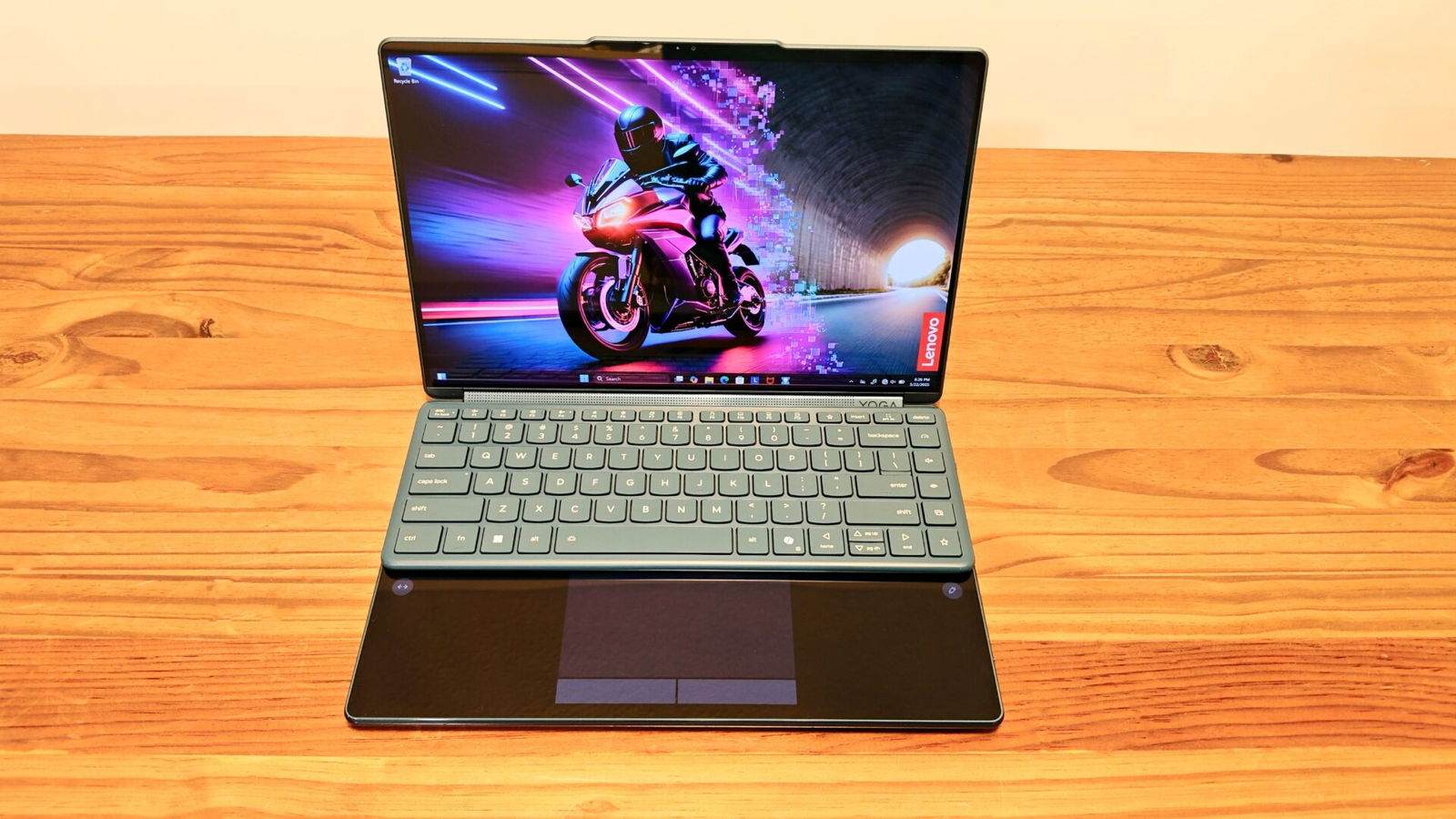
Continuing an examination of the 9i, Lenovo has opted for rounded edges for its adaptable laptop. The result is a laptop that is quite comfortable to hold, either as a dual-screen portrait-style tablet or a single-screen tablet. While a little heavy if issued this way for long stretches, it does, nonetheless, fit well if cradled in one arm while using the pen.
The I/O for the Yoga Book 9i is pretty sparse and speaks to its more modular design. The left side includes a single Thunderbolt 4 port while the right side offers two additional Thunderbolt 4 ports, a power switch and an E-shutter switch (a virtual shutter for the webcam). All three Thunderbolt ports can be used for charging, which offers flexibility in setup, but to connect additional peripherals that require a port other than Thunderbolt, you’ll be carrying an additional hub accessory.
With that being said, the Yoga Book 9i does offer excellent wireless connection options via its Bluetooth 5.4 and Wi-Fi 7 connections, which in the world of wireless peripherals, should work well for most people. All of these design elements speak to the Yoga Book’s modular design, its focus on productivity and adaptability.
Speaking to the former, the Yoga Book 9i is first and foremost a productivity machine. Featuring the aforementioned Intel Ultra 7 255H processor, the 9i fits well as an everyday productivity machine. The 16GB LPDDR5 RAM and 1 TB M.2 SSD provide a solid processing laptop for everyday use. Email, word processing, and Excel work are all easily handled by the Yoga Book 9i, with multi-tasking (both thanks to the processor and modular design) at the forefront of this unique laptop’s design.
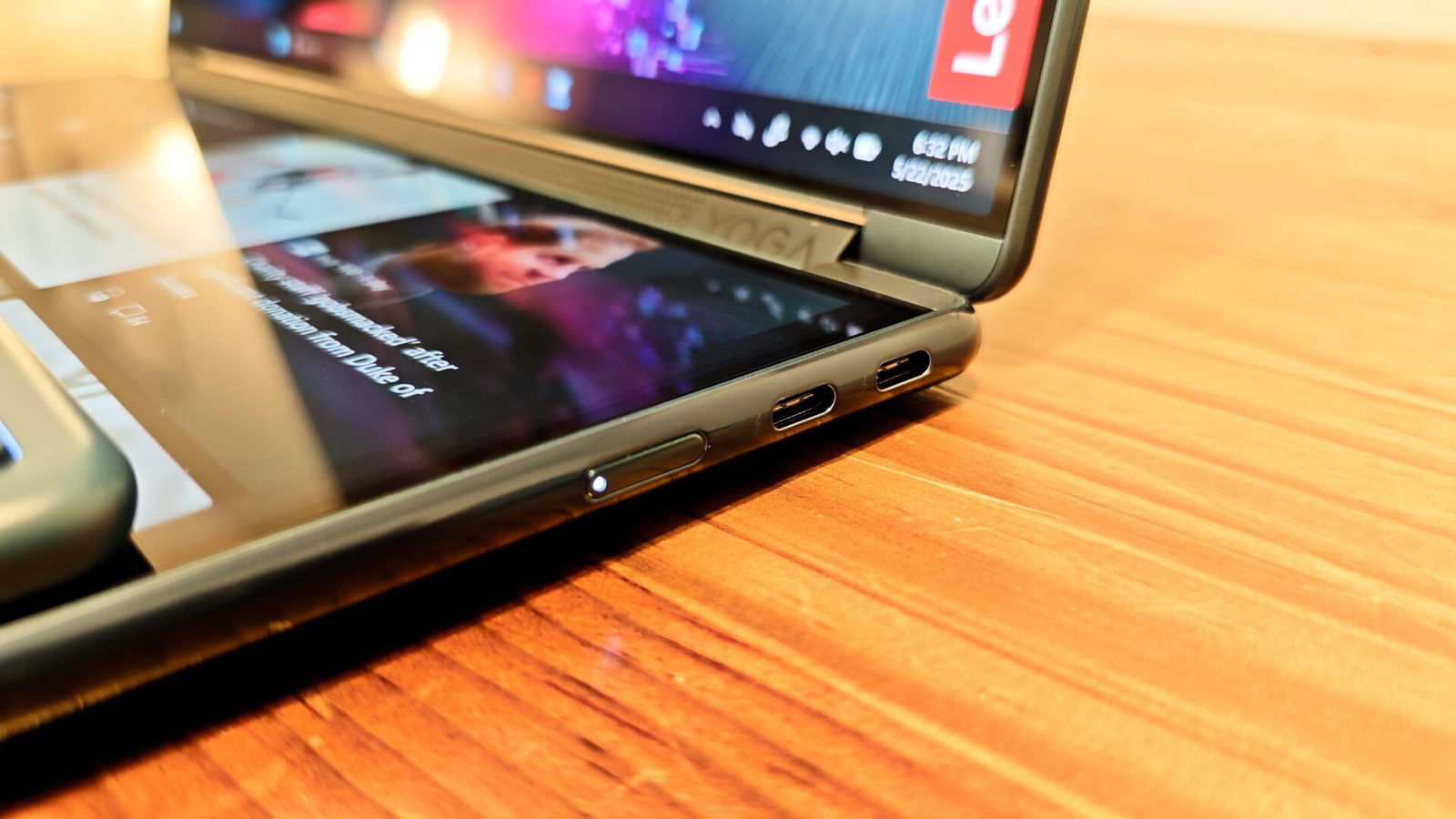
Heavier processing, though, such as video editing or complex 3D modelling, is a bit of a pain point for the Yoga Book 9i. It can handle both types of work thanks to the built-in Arc GPU, but it still lacks the power to offer a completely smooth user experience. So while it’s possible to edit 4K footage or do 3D modelling, the Yoga Book 9i performs better with standard CAD work and 2D drafting. The dual-screen setup is a welcome offering in this regard and is a game changer for everyday productivity, for the most part.
On the note of processing, the battery life on the Yoga Book 9i is decent when factoring in the dual display. In real-world testing, I averaged about 6.5 hours of continual use with some days pushing closer to 7.5 hours. While this might seem a bit low, the fact that the 9i is powering two POLED displays and manages this battery time is quite impressive. While it won’t get you through a whole day on battery life, it will hold its own for longer meetings or presentations easily.
Before diving into the various forms the Yoga Book 9i can take on, it’s worth highlighting the User Center Software. Lenovo’s User Center App provides an incredible amount of information required to leverage every feature the Yoga Book has to offer. Its clean user interface and robust feature set help the user get their head around the many modes, menus and capabilities of the Yoga Book 9i.
It’s easy to access and provides visual examples of every feature and mode the 9i has to offer. Lenovo has done an excellent job refining the user experience. As the most adaptable dual-screen laptop I’ve reviewed, User Center has been vital to getting the most out of Lenovo’s latest system.
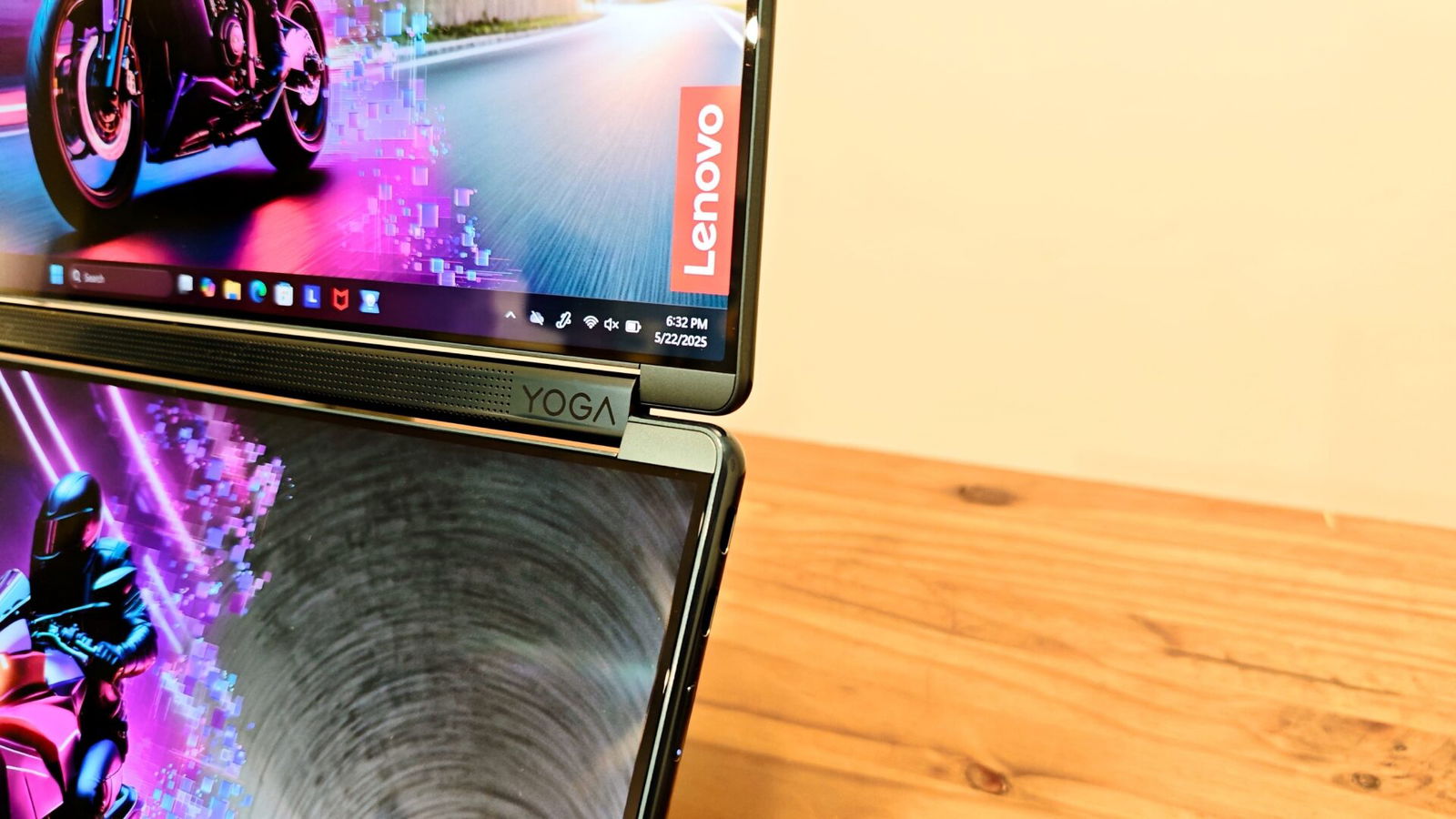
The only other note I want to make before highlighting and discussing the various setups the 9i offers is how quickly and seamlessly the screens adapt to whatever mode the Yoga Book 9i is in. In testing, no matter how quickly I swap between setups, the screens seamlessly adapt and are ready for whatever is next. I’ve appreciated the speed of these transitions, which is key to a positive user experience.
Shifting now to the various modes, while I’ll briefly mention all of them, there are only a few that I’ll unpack in detail. Starting with the dual landscape mode, the 9i can, thanks to the included folio stand, bluetooth keyboard, pen and mouse, essentially become dual dual-screen vertical workstation. In this mode, the Yoga Book 9i becomes a powerhouse of productivity and functionality.
“Email, word processing, and Excel work are all easily handled by the Yoga Book 9i, with multi-tasking (both thanks to the processor and modular design) at the forefront of this unique laptop’s design.”
The laptop folds open in landscape mode and rests on the folio stand with the mouse and keyboard housed at the bottom of the laptop. The result is a streamlined dual-monitor PC setup that requires very little setup. It’s simple to use and my favourite way to leverage the Yoga Book’s flexible design. This is the ideal setup for those who work in various locations but still crave a dual-screen setup, in part because you don’t need to carry a second screen with you, but also because in this mode, you need minimal desk space thanks to the vertical layout. It has been my go-to mode during testing.
The one drawback to this orientation, however, is that it isn’t nearly as flexible to pick up and go as a traditional clamshell or laptop mode. It requires the most setup and the folio stand, while quite usable, isn’t the sturdiest. If you need to reposition the Yoga Book 9i while in this dual landscape mode, be cautious when moving it, as the back support can shift if you slide the unit. When simply set in place, the laptop feels sturdy and functional.
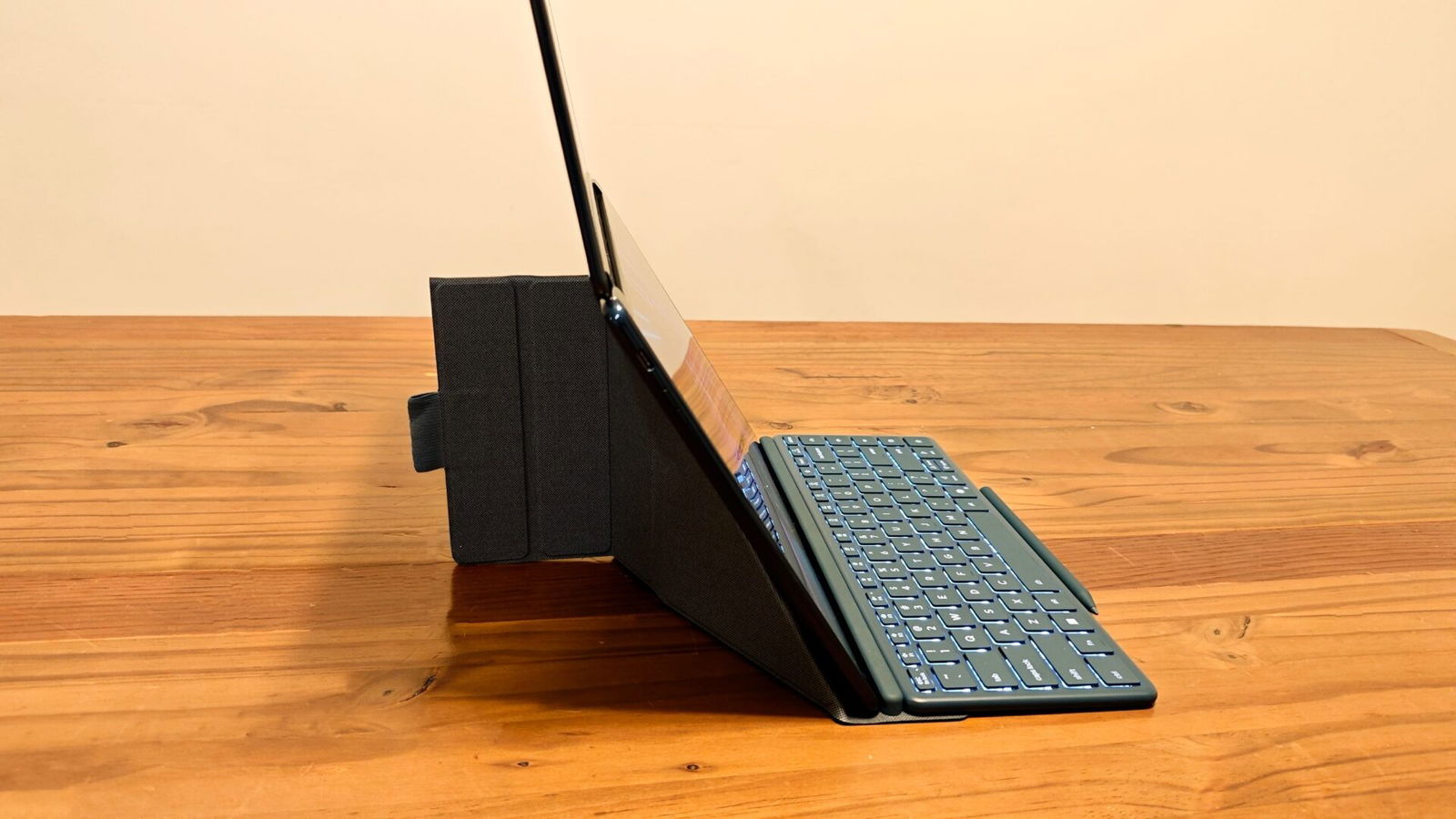
Dual portrait mode, which leverages the same basic setup but in portrait mode, is a great way to work for those who prefer vertical monitor setups. It functions similarly to dual landscape mode, with the 9i seamlessly identifying its orientation and adjusting the screen’s rotation to match the desired layout. While it does occupy a bit more desktop space, the advantage is that it doesn’t sit quite as high on a desk or table, providing a reprieve from the curious stares of other patrons while working at your local coffee shop.
The key with both of these setups is that they require the use of the aforementioned peripherals. If you’re someone who sets up for the day in a specific space and works until it’s time to go home, the Yoga Book 9i is an amazing laptop that provides incredible functionality. However, if you frequently need to set up while commuting, then you’ll find both of these setups cumbersome.
This, of course, is where the clamshell or laptop mode becomes important. The Yoga Book 9i offers two variations on the traditional laptop design: physical keyboard, virtual touchpad and pen, and virtual keyboard, virtual touchpad and pen. There’s a lot to unpack here, so let’s jump in.
Physical keyboard and virtual touchpad are, hands down, the ideal way to leverage the laptop mode. Lenovo has designed the keyboard to magnetically attach the lower display, and once attached, it wakes up the virtual touchpad automatically. In this mode, the Yoga Book 9i functions most like a traditional laptop.
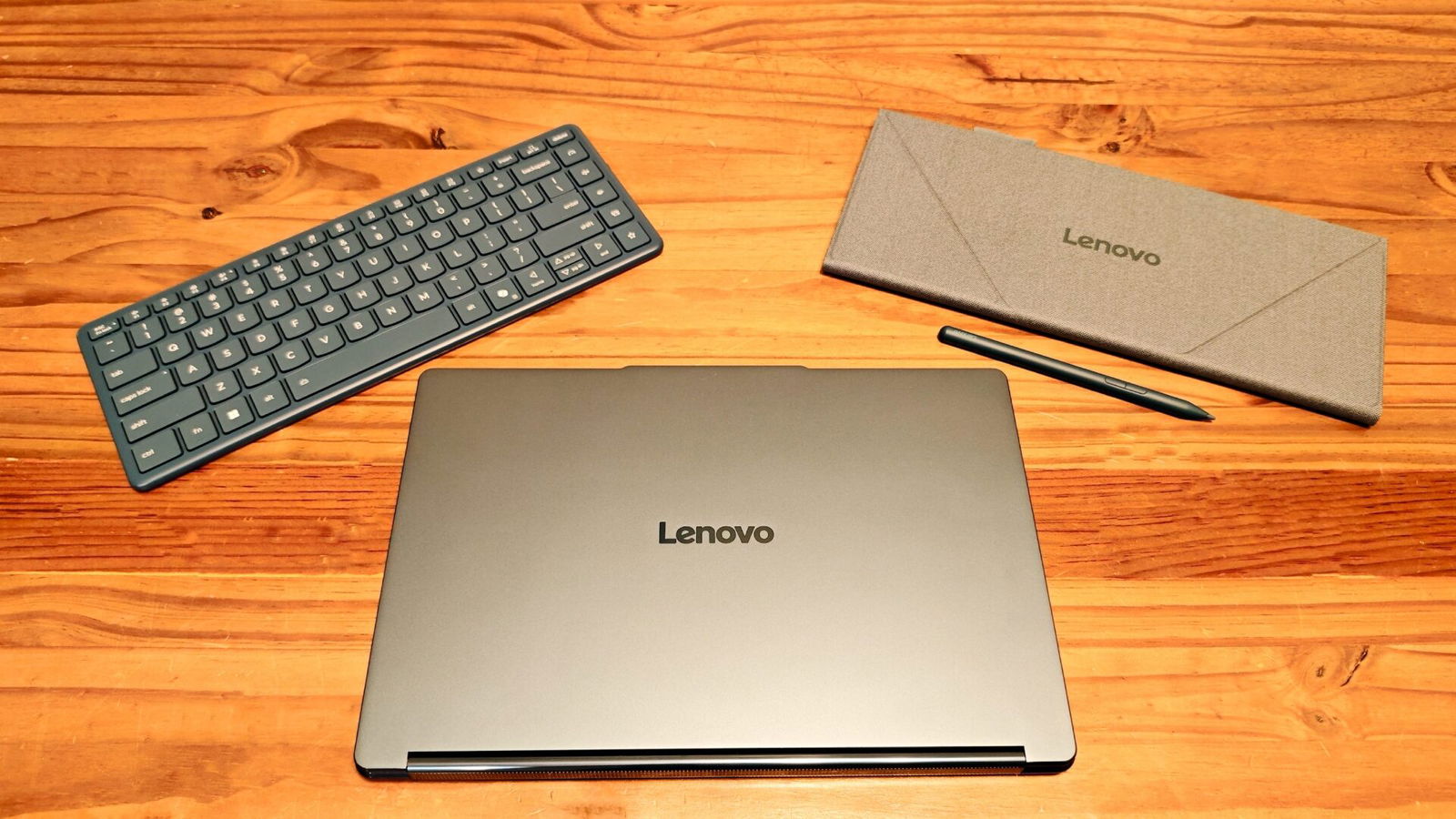
There are two critiques: it requires attaching the keyboard, which means that if you work while commuting, you’ll be pulling a peripheral out of your bag. This can be cumbersome if in a hurry, and if in tight spaces such as an airplane, it is simply frustrating. The second critique is that due to the physical height difference between the keyboard and display, your palms rest at an uncomfortable angle and also on an active touchscreen. More than once, I’ve ended up bumping the touchscreen and watched the focus window swap.
The second version, virtual keyboard, virtual touchpad and pen, suffers from similar concerns, though amplified due to the nature of the design. I’ve found using the virtual keyboard to be a hot mess in practical testing. Typing for any length of time is a frustrating experience as I frequently touch another part of the bottom display, moving the focus off my current window. In a pinch, you can send an email, but to work for any length of time isn’t reasonable. It simply isn’t functional for everyday productivity. In laptop mode, the Yoga Book 9i struggles to compete with traditional designs.
However, I have found that when leveraging the second screen as a writing pad with the pen, the Yoga Book 9i becomes a powerhouse for note-taking. Often, I take notes on video presentations on my tablet in OneNote, but of late have found myself opening OneNote on the lower screen while watching the video on the upper screen. This setup has been a game-changer for note-taking for training or Zoom meetings. The pen works quite well and feels responsive and intuitive to use.
“The Yoga Book 9i from Lenovo is a powerful laptop that, when utilized in the right setting, can be a game-changer for productivity.”
The final mode to highlight is tablet mode. In this mode, the Yoga Book 9i excels. While there are variations on this mode, I’ve found the 9i to work well regardless of the format you choose. As mentioned, the pen works well and using the virtual keyboard in this context is much easier than in laptop mode. As a fun bonus, the Yoga Book 9i can be set up in a sort of presenter mode or A-frame layout, allowing you to mirror your displays. This is ideal for showing off a project or presenting information to a colleague.
While there are slight variations on the highlighted forms, these are the core modes offered by the Yoga Book 9i. After weeks of everyday use in testing, I have mixed feelings about the Yoga Book 9i. On the one hand, its flexibility and dual-screen design are a game-changer for everyday work and productivity. It truly has changed how I work. The dual landscape mode has become my go-to setup every day when coming into work. As someone who benefits from a multi-display setup, the Yoga Book 9i is my dream laptop.
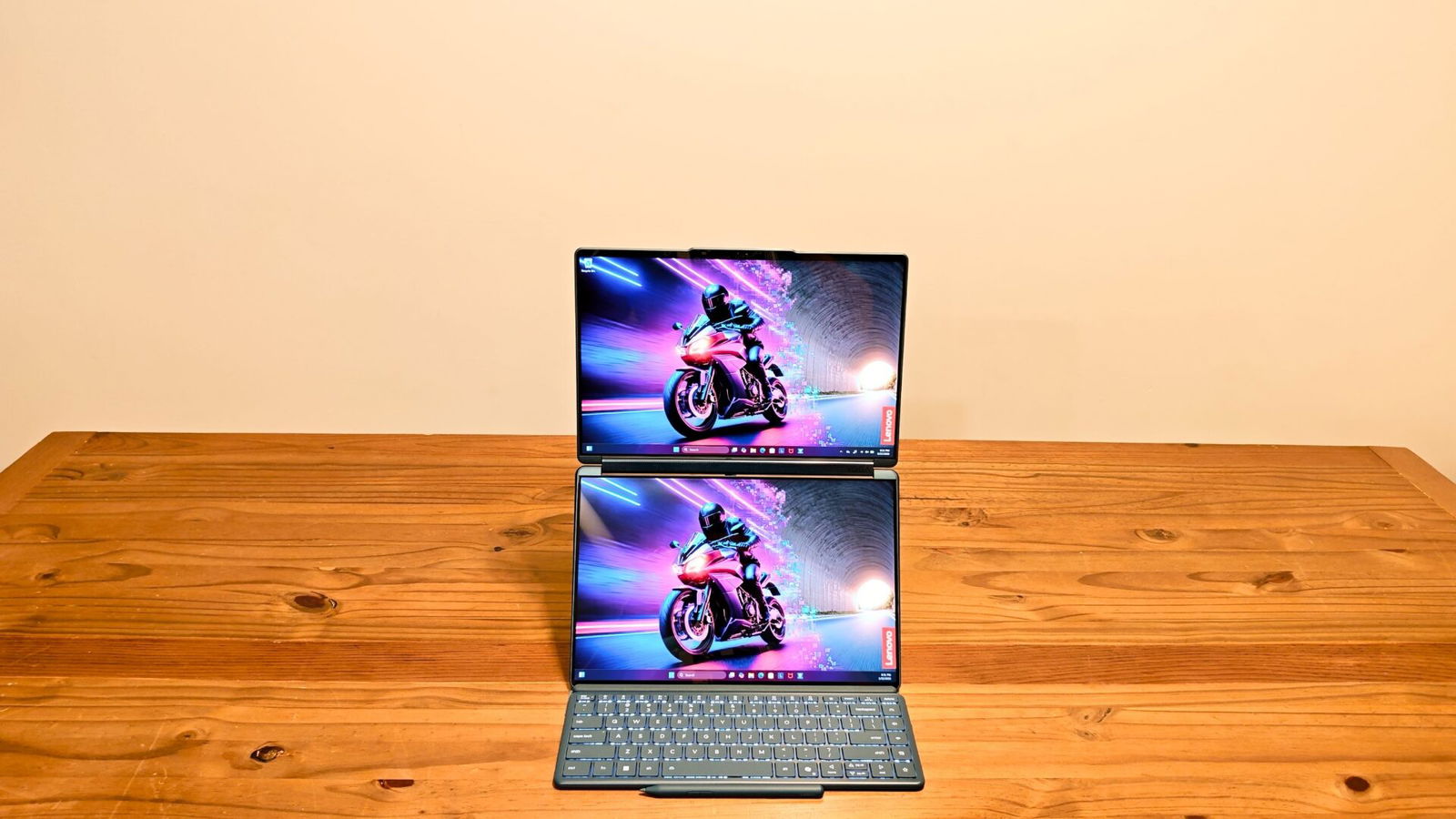
If, however, you need a more traditional laptop experience, the Yoga Book 9i, despite offering this mode, cannot compete with a traditional laptop experience. The virtual keyboard and touchpad do not compare to their physical counterparts, and, as mentioned, the combination of physical and virtual is less than desirable for real productivity. As such, the Yoga Book 9i is a very case-specific laptop that will excel in specific scenarios while falling short in others.
So, who is this for? If you are someone who works in a consistent space and wants a dual-screen setup, I cannot recommend the Yoga Book 9i enough. If you want the flexibility of a tablet and desktop experience in one compact package, the Yoga Book 9i is your laptop. If, however, you need a more traditional portable laptop (clamshell) experience, the 9i falls short.
The Yoga Book 9i from Lenovo is a powerful laptop that, when utilized in the right setting, can be a game-changer for productivity. While it falls short as a traditional laptop, it makes up for this shortcoming thanks to its dual landscape, portrait and tablet modes. While not for every consumer, the Yoga Book 9i is worth considering for specific users.
- The world’s first full dual-screen, multi-mode laptop
- Two stunning 13.3″ PureSight OLED displays for versatile use
